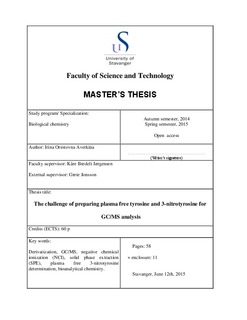| dc.contributor.author | Averkina, Irina | |
| dc.date.accessioned | 2015-09-16T13:30:14Z | |
| dc.date.available | 2015-09-16T13:30:14Z | |
| dc.date.issued | 2015-06-12 | |
| dc.identifier.uri | http://hdl.handle.net/11250/300319 | |
| dc.description | Master's thesis in Biological chemistry | nb_NO |
| dc.description.abstract | 3-Nitrotyrosine and the 3-nitrotyrosine/tyrosine ratio has been acknowledged as a biomarker of nitro-oxidative stress and its elevated level in biological fluids is associated with a wide range of clinical conditions. Despite the importance of 3-nitrotyrosine as a marker of oxidative stress the optimal method for high throughput analysis of clinical samples has yet to be developed. Due to its nanomolar concentration, quantitation of 3-nitrotyrosine is quite challenging. Nowadays, there are many analytical assays available for determination of 3-nitrotyrosine, but the obtained values vary widely and their reliability are still controversial. The purpose of this research was to develop an optimal analytical procedure for simultaneous determination of plasma free 3-nitrotyrosine and tyrosine by gas chromatography (GC) coupled to single stage mass spectrometry (MS) with negative chemical ionization (NCI). The procedure would comprise amino acid isolation by solid phase extraction (SPE), chemical derivatization and gas chromatography/mass spectrometry (GC/MS) analysis. The emphasis was given to the chemical reactions with formation of fluorinated derivatives, which would provide low detection limits of 3-nitrotyrosine. Two types of extraction cartridges were used for the amino acid isolation and four strategies for the chemical derivatization were evaluated in the present paper. The cartridges with enhanced polar and aromatic selectivity showed higher recovery of the amino acids compared to the cation exchangers. The successful derivatization based on ethyl chloroformate (EtCF)/heptafluorobutanol (HFBOH) was extensively studied and attempts were made to optimize it. The one-step derivatization with pentafluorobenzyl bromide (PFBBr) did not yield any stable derivatives. Although easy to perform, derivatization with EtCF/HFBOH or PFBBr did not provide sufficiently low detection limits. Acceptable limits of detection (0.11µg/L) and quantitation (0.13µg/L) were achieved only during the four-step derivatization of 3-nitrotyrosine calibration standard with heptafluorobutyric anhydride/trimethylsilyldiazomethane. In subsequent experiments with human plasma these values proved to be insufficient because of a negative plasma matrix effect on the reaction yield. | nb_NO |
| dc.language.iso | eng | nb_NO |
| dc.publisher | University of Stavanger, Norway | nb_NO |
| dc.relation.ispartofseries | Masteroppgave/UIS-TN-IMN/2015; | |
| dc.rights | Navngivelse-Ikkekommersiell 3.0 Norge | * |
| dc.rights | Navngivelse-Ikkekommersiell-IngenBearbeidelse 3.0 Norge | * |
| dc.rights.uri | http://creativecommons.org/licenses/by-nc-nd/3.0/no/ | * |
| dc.subject | GC/MS | nb_NO |
| dc.subject | negative chemical ionization (NCI) | nb_NO |
| dc.subject | plasma free 3-nitrotyrosine determination | nb_NO |
| dc.subject | bioanalytical chemistry | nb_NO |
| dc.subject | biologisk kjemi | nb_NO |
| dc.subject | derivatization | nb_NO |
| dc.subject | solid phase extraction (SPE) | nb_NO |
| dc.title | The challenge of preparing plasma free tyrosine and 3-nitrotyrosine for GC/MS analysis | nb_NO |
| dc.type | Master thesis | nb_NO |
| dc.subject.nsi | VDP::Mathematics and natural science: 400::Basic biosciences: 470::Biochemistry: 476 | nb_NO |

